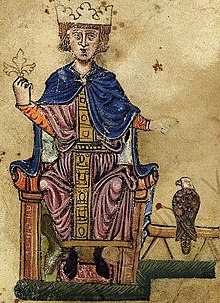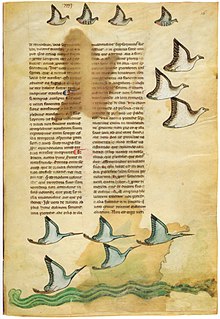De arte venandi cum avibus

De arte venandi cum avibus (lat., Lit. about the art of hunting with birds ), German title Von der Kunst zu beizen , also known as the falcon book , is a textbook on hunting and ornithology that was published between 1241 and 1248 by Friedrich II. Was written in Latin and annotated by his son Manfred .
background
Medical advice for the care of falcons has been handed down in addition to works from the oriental-Arab culture in the West since the 10th century, but they go back to older models. The essential treatises on falconry from the 12th century were written at the Norman royal court in Palermo, but they were relatively brief. Frederick II was also familiar with Aristotle 's De animalibus libri , a treatise on animals that had been translated from Arabic into Latin by his court astrologer Michael Scotus ; He was also familiar with De scientia venandi per aves , a textbook by the Arab falconer Moamin, which had been translated by a magister Theodor on Friedrich's order in 1240 and was available in many copies.
content
In addition to an introduction to general ornithology, the work also contains instructions on rearing, training and using hunting falcons.
The text is illustrated by over 900 pictures of around 80 different bird species. They show the specific postures of birds, but also falconers and their activities and tools from falconry. It also provides information about running a falconry.
The falcon book is based on the author and his falconers' own practical experience. Friedrich formulates his goal as follows: Our intention is to make visible the things that are as they are ("Intentio vero nostra est manifestare ea quae sunt sicut sunt"). The emperor did not shy away from questioning recognized authorities such as Aristotle and Pliny , if their statements did not agree with his own experience.
rating
The Falkenbuch remained the standard work on pickling until well into modern times . This is mainly due to the scientific accuracy and systematic approach of the author, who works with empirical methods and is thus far ahead of his contemporaries. He trusts in his own experience gained from experiments: by covering the eyes of a bird of prey, he tries to find out whether he uses his sense of smell for hunting; he also experiments with bird eggs to find out whether the sun's heat is sufficient for the brood. His experiences give the author the necessary support to also dare to criticize Aristotle.
Due to the rich book illumination, the work is also of art historical importance. A separate exhibition unit was dedicated to the work at the Lower Saxony state exhibition, Kaiser Friedrich II. World and Mediterranean Culture ; In the exhibition catalog, the historian Michael Menzel describes the falcon book as the “Big Bang of ornithological knowledge”.
Tradition and edition history
The original manuscript of Frederick II was lost during the siege of Parma in 1248 . In the transmission of the text, two editors can be identified:
- a version with the first two books (short version), which can be found today in Rome and Vienna, Geneva, Stuttgart and twice in Paris;
- the most famous version of the textbook is the Codex Palatinus latinus 1071 , an illuminated manuscript , today kept in the Vatican Library , which was commissioned by Frederick's son Manfred of Sicily . The Code of parchment in two columns 111 comprises sides in the described Folio format (here about 36 × 25 cm). This probably most beautiful copy of the text contains the extraordinarily lifelike pictures of birds, falconers and their tools in brilliant colors. The manuscript also has Manfred's annotations, each marked with "Rex", "Rex Manfredus" or "addidit Rex" (lat. King , King Manfred , the King added ).
- a version in six books, today in Bologna (Biblioteca Universitaria Ms. lat. 717), Paris, Nantes, Valencia, Rennes and Oxford;
The first translation of the work was done into French and was commissioned around 1300 by Jean II , Lord of Dampierre , Vice-Count of Troyes .
The first printed edition of the Latin manuscript (in the two-book version) was published in Augsburg in 1596 by Markus Welser . Joachim Camerarius had temporarily given him the Manfred Codex, which was then in his possession. The manuscript probably came to the Bibliotheca Palatina through his son Ludwig Camerarius . Ludwig had been in the service of the Electors Friedrich IV and Friedrich V. for a long time . But the work was only to be at home for a very short time in the splendid Palatine building above the Neckar . After Heidelberg was taken by Tilly, this optimus Germaniae literatae thesaurus (Germany's most precious book treasure) went from Duke Maximilian I to Pope Gregory XV as a token of thanks for the victory of the Catholic League over the Protestant Union . to Rome. In the spring of 1623 the books were transported across the Alps.
Effects on modern falconry
In the 18th century, Karl Wilhelm Friedrich von Brandenburg-Ansbach ran one of the largest falconry centers in Europe with 51 employees on his country estate in Triesdorf near Ansbach. In 1756 he commissioned the dean and rector of the Gunzenhausen Latin School, Johann Erhard Pacius, to translate Frederick II's falcon book under the title Von der Kunst zu beizen ; the latter carried out the "order", but had to exchange ideas with the Flemish falconers at the court for the technical terminology of the pickling hunt. After the DFO revived falconry in Germany in 1923, Pacius' word lists were partially adopted. This is how Flemish expressions came into the technical language of modern German falconry.
Translations
- Emperor Friedrich II .: About the art of hunting with birds. trans. and ed. by Carl Arnold Willemsen. 2 volumes. Insel, Frankfurt am Main 1964.
- H. Schöpffer: The Hohenstaufen Emperor Friedrich II books on the nature of birds and falconry, with the permission of King Manfred. Paul Parey, Berlin 1896.
- Casey A. Wood, F. Marjorie Fyfe: The Art of Falconry: Being the De Arte Venundi cum Avibus of Frederick II Hohenstaufen. Stanford University Press, Stanford 1943.
- Anne Paulus, Baudouin Van den Abeele: Frédéric II de Hohenstaufen, L'art de chasser avec les oiseaux. Traduction intégrale en français du traité de fauconnerie De arte venandi cum avibus. (= Cynegetica. 1). J. Laget - LAME, Nogent-le-Roi 2000.
Facsimile editions
A facsimile edition was prepared from 1940 by the German historian Carl Arnold Willemsen and appeared in 1969 in the Academic Printing and Publishing House in Graz. After this edition, a full (scaled-down) reproduction was published as a paperback from 1980 by Harenberg Verlag .
literature
- Baudouin van den Abeele: The Latin treatises on falconry of the Middle Ages . Dissertation. UC Louvain 1991.
- Stefan Georges: The second falcon book of Emperor Friedrich II. Sources, origin, tradition and reception of the Moamin . With an edition of the Latin tradition (= knowledge culture and social change. Vol. 27). Akademie Verlag, Berlin 2008, ISBN 978-3-05-004483-5 . review
- Johannes Fried : Emperor Friedrich II as a hunter. In: Werner Rösener (Ed.): Hunting and court culture in the Middle Ages , V&R 1997, pp. 149–166.
- Heinz Peters: falcon, falcon hunt, falconer and falcon book. In: Real Lexicon on German Art History. Tl. 6, 1973, pp. 1251-1366.
- Matthias Schramm: Frederick II of Hohenstaufen and Arabic Science. in Science in Context 14, 2001, pp. 289-312.
- Carl Arnold Willemsen (ed.): The falcon book of Emperor Friedrich II. After the splendid manuscript in the Vatican library. (= The bibliophile paperbacks. No. 152). Harenberg, Dortmund 1980, ISBN 3-88379-152-0 .
Web links
- Volume 1 of the edition of Willemsen PDF, 12.4 MB
- Volume 2 of the 1942 edition PDF, 12.6 MB; both by Thomas Gloning, Giessen University.
- Prologue in the Bibliotheca Augustana
- Books and essays on Falkenbuch in the Opac of the Regesta Imperii
- Books and essays on De arte venandi in the Opac of the Regesta Imperii
- The parrots in Emperor Frederick II's falcon book
- Biblioteca Apostolica Vaticana Cod. Pal. lat. 1071 (1258–1266) ( Heidelberg University Library )
- Manuscript - Pal. lat. 1071 (Biblioteca Apostolica Vaticana)
Remarks
- ↑ a b The Falcon Book of Frederick II. Akad. Dr.- u. Verlag-Anstalt, Graz 2000, ISBN 3-201-01740-X .
- ↑ Hawks . In: Meyers Konversations-Lexikon . 4th edition. Volume 6, Verlag des Bibliographisches Institut, Leipzig / Vienna 1885–1892, pp. 9–11.
- ↑ According to the prologue, Friedrich wrote the book of falcons at the insistence of Michael Scotus ("Presens opus agendi nos induxit instans tua petitio, vir clarissime M [ichaele] S [cote]").
- ↑ Moamin's treatise, but also the works of Dancus rex, Guillelmus Falconarius and Guicenna were published in Friedrich's so-called “second book of falcons”. Stefan Georges: The second falcon book of Emperor Frederick II on sehepunkte.de
- ↑ On the lower left the chapter on the formation that migratory birds take on their journey begins: “Ordinem autem hunc servant in transeundo.” P. 39 in the edition of Willemsen.
- ↑ Friedrich II. States, for example, that the migratory birds alternate at the head of a formation contrary to Aristotle's writings: “Non est ergo verisimile, quod scribitur ab Aristotile, quod una semper sit dux aliarium, nam si verum esset hoc, non permutaretur dux , sed semper duceret. ”p. 39 in the Willemsen edition. Marcel Schwarzenberger: Staufer-Kaiser amazes the world on chronico.de
- ↑ Marcel Schwarzenberger: Staufer-Kaiser amazes the world on chronico.de
- ^ CH Haskins: The "De Arte Venandi cum Avibus" of the Emperor Frederick II. In: The English Historical Review. Vol. 36, No. 143, Jul. 1921, pp. 337-339.
- ^ RW Corrie: De arte venandi cum avibus / L'art de la chace des oisiaus. In: Speculum . Vol. 74, No. 2, April 1999, pp. 414-417.
- ↑ a b Friedrich II: From the art of pickling. Afterword, Neumann-Neudamm, Melsungen 1994, ISBN 3-7888-0672-9 .
- ↑ Carl Arnold Willemsen (Ed.): The Falcon Book of Emperor Friedrich II. After the splendid manuscript in the Vatican Library. (= The bibliophile paperbacks. No. 152). Harenberg Verlag, (Commentary and Introduction) p. 234.


